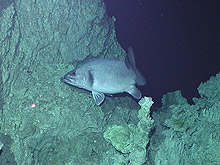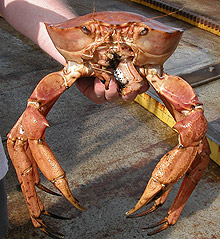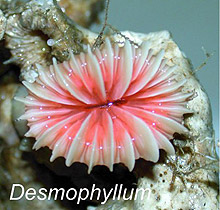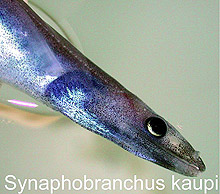Lost City Macrofauna
Timothy Shank
Assistant Scientist
Biology Department
Woods Hole Oceanographic Institution
Kate Buckman
Graduate Student
WHOI/MIT Joint Program in Oceanography
When the Lost City Hydrothermal Field first emerged in the lights of a submersible in 2001 the venting spires did not appear to teem with life like most other vent fields around the world. There were no large red tubeworms, fields of clams or mussels typical of eastern Pacific vents or massive swarms of shrimp common to vents along the Mid-Atlantic Ridge. Yet in 2003, recovered pieces of Lost City chimney spires revealed numerous animals less than an eighth of an inch long. To date, over 70 potential species have been identified from Lost City, a surprisingly high biodiversity which is more than double the number of species found on vent chimneys typical of the Mid-Atlantic Ridge.
The Lost City vent site may look barren at first glance, but look a little deeper, into the cracks and crevices of the carbonate through a microscope and the animals become obvious. Tiny invertebrates dwell within the cracks of these highly sculpted and actively venting porous carbonate structures. Gastropod snails, shrimp-like crustaceans (including amphipods that migrate daily from the upper surface waters to the Lost City area), and numerous polychaete worms (of which there are at least five new species) all live here. Nematode worms, flea-like ostracods, and small bivalves can also be found on these amazing structures. The biomass (net weight of animals) is small compared to a typical hydrothermal vent on the Mid-Atlantic Ridge. The biggest contributors to the biomass at Lost City are the larger more mobile megafauna, including the (grouper-like) wreckfish; cut-throat eels; and large red geryonid crabs, all readily visible around the spires.
Hydrothermal vent sites around the world host animals that are endemic, animals that are found living only in these vent areas. A pattern exists where typical vent areas exclude almost all other general deep-sea animals for some distance from hydrothermal activity. Non-venting habitats less than a few meters away (e.g., the sides of inactive solidified carbonate structures, sedimented areas, and breccia cap rock just to the north of the field) are dominated by hard corals (Lophelia pertusa and Desmophyllum), octocorals (gorgonians), galatheid crabs, turrid gastropods, foraminifera, pteropods, urchins, asteroids, ophiuroids, and typical deep-sea barnacles. Vent and non-vent habitats are strongly segregated at the Lost City.

This wreckfish, swimming between carbonate chimneys, is just over 1 meter in length. They are common near the summit of the massif and within the Lost City Field at a depth of ~750-800 m. They routinely followed the submersible Alvin during many dives in 2003. Click image for larger view and image credit. (HR)

This crab was recovered from the edge of the Lost City field in 2003 at a water depth of ~ 750 m. Animals of this size are rare within the field. Although total biomass is small the diversity of fauna is as high or higher than that of black smoker sites along the Mid-Atlantic Ridge. Click image for larger view and image credit. (HR)




























